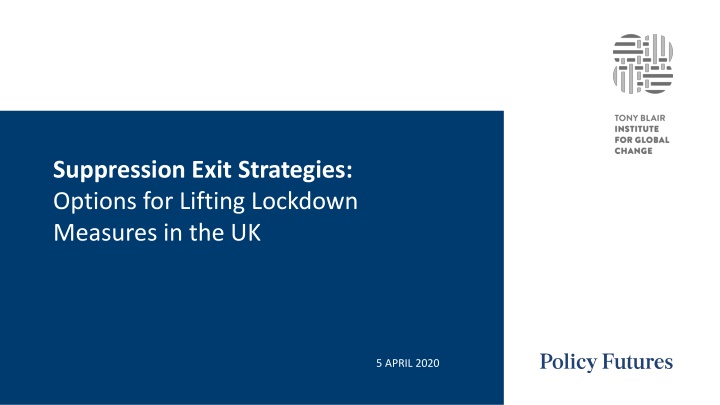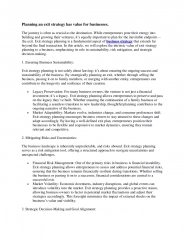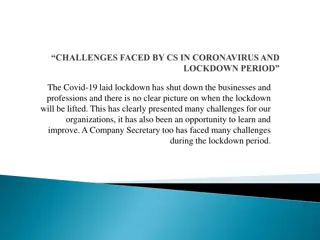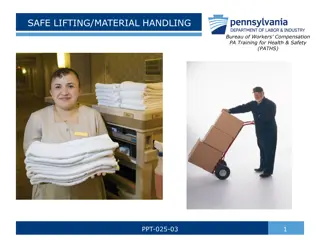
Exit Strategies for Lifting UK Lockdown Measures April 2020
"Explore options for lifting lockdown measures in the UK, including scenarios such as maintaining lockdown until a vaccine is developed, gradually easing off restrictions, adaptive triggering, and more. Consider the trade-offs involved in balancing health concerns and economic impacts amid the COVID-19 pandemic."
Download Presentation

Please find below an Image/Link to download the presentation.
The content on the website is provided AS IS for your information and personal use only. It may not be sold, licensed, or shared on other websites without obtaining consent from the author. If you encounter any issues during the download, it is possible that the publisher has removed the file from their server.
You are allowed to download the files provided on this website for personal or commercial use, subject to the condition that they are used lawfully. All files are the property of their respective owners.
The content on the website is provided AS IS for your information and personal use only. It may not be sold, licensed, or shared on other websites without obtaining consent from the author.
E N D
Presentation Transcript
Suppression Exit Strategies: Options for Lifting Lockdown Measures in the UK 5 APRIL 2020
Context The UK implemented a complete lockdown on 24 March to prevent a spike in cases that would overload ICUs and potentially cause half a million deaths. HM Treasury announced a powerful package of measures to put the economy into an induced coma preventing workers being laid off and companies going under until suppression measures can be lifted. A fortnight on, our understanding has evolved in two ways: Experience around the world suggests that easing off the current measures even slightly would accelerate the spread to an unmanageable degree. Complete lockdown is currently the only option available. Rapidly rising unemployment suggests that even the Treasury s extensive support measures may not be able to prevent severe long-term economic damage. Consequently, once new case numbers are reduced, there is an urgent need to find an exit strategy from the lockdown that limits the health damage while allowing the economy to revive. This paper outlines some options and the trade-offs involved.
What are the options for moving out of suppression? 1
Exit strategies from lockdown Six possible exit strategies from suppression measures Scenario 1 Lockdown until vaccine Retain reasonably heavy suppression measures until a vaccine is developed. Scenario 2 Ease off gradually Ease off suppression measures such as event bans or school closures to keep infection rate steady and manageable. Scenario 3 Adaptive triggering Ease lockdown once infections decline, reimpose when they begin to rise, repeat. Scenario 4 Permits Use cheap antibody testing to identify immunity and allow those people out ; retain measures for those without a passport . Scenario 5 Weekly testing In the early stages of an outbreak, proactive screening facilitates active case finding, as well as contact tracing and quarantining. Scenario 6 Contact tracing & testing Rollout of a contact-tracking app, combined with widespread PCR testing, to alert people who ve been close to someone who subsequently tests positive.
Scenario 1: Lockdown until vaccine The baseline option is to maintain the status quo until a vaccine is developed. However, best estimates suggest that a vaccine could take over a year to develop and deploy. 12-month lockdown is likely to be practically impossible and economically extremely harmful: As case numbers drop, unemployment rises, and businesses go under, it may become politically impossible to maintain the current measures. Even if it were possible, it could cause the economy to shrink by a third for a year. The associated damage would preclude any rapid economic recovery potentially large and permanent hit to living standards.
Scenario 2: Ease off on lockdown gradually In principle it might be possible to remove some of the measures currently in place while retaining others, in order to keep the reproduction number (R) below or very close to 1. Evidence to date suggests this is problematic. Imperial College research suggests that of all measures taken so far, only full lockdown may have reduced R to around 1. Easing off alone therefore seems likely to cause another outbreak. Source: MRC Centre for Global Infectious Disease Analysis Report 9
Scenario 3: Adaptive triggering Imperial College has proposed adaptive triggering : Social-distancing measures are implemented when ICU admissions pass a given threshold. However, shutdowns would be regular and last two-thirds of the year, making this little different to permanent lockdown from an economic perspective. Lockdowns could be less frequent if this approach was combined with others. Source: MRC Centre for Global Infectious Disease Analysis Report 9
Scenario 4: Immunity permits Antibody tests to identify those who have had the virus and are therefore immune are potentially rapidly scalable, allowing some to return to work. However this would create major ethical, political and economic problems: Likely that only a minority will have had the disease in two months, limiting the economic benefits (although this is still uncertain). With unemployment high, it will be politically unsustainable to allow some to work and keep others on benefits until a vaccine emerges. Would be hard to maintain current measures incentive for people to actively try to contract the virus. Source: MRC Centre for Global Infectious Disease Analysis Report 13
Scenario 5: Weekly national testing Weekly PCR testing for the whole country, as proposed by Professor Julian Peto. He argues the UK needs 14,000 testing machines and probably already has this capacity. Two significant hurdles suggest this would not be possible for at least several months: Current challenges of the availability of reagents suggest that it could take many months to achieve the 10 million tests per day for a testing only approach. Administration of such a system would be complex, requiring a large trained workforce.
Scenario 6: Contact tracing plus mass testing Contact tracing (CT) involves: identifying someone who has a disease; listing all those who have come into contact with the person; and monitoring or isolating those people. Whether CT can bring an epidemic under control (r<=1) depends on: 1. Transmissibility of the disease before symptoms appear. 2. The proportion of contacts traced. 3. Time between the onset of symptoms and isolation. App-enabled contact tracing can act on 2 and 3 and is operational in some countries notably Singapore (see section 3). Combining this with mass testing (PCR and antibody) would strengthen its effectiveness.
Exit strategy trade-offs? Assumes lockdown until solution scenario is implemented It is unlikely any solution will be available in <2 months Dependent on the speed required to implement solutions, both deaths and economic impact increases 30% Lockdown until vaccine Weekly testing 1 5 Adaptive triggering Immunity permits 3 4 20% Lost Ease off gradually economic output 2020-2021 Contact tracing & testing 6 2 KEY ? X Scenario number 10% 12-18 months until viable 3 April situation ? 6-12 months until viable Prevent transmission zone ICU overload zone 2-6 months until viable 0 500k Deaths Herd Immunity Illustrative only. Health assumptions based loosely on MRC Centre for Global Infectious Disease Analysis Reports 9 and 13
Exit strategies from lockdown Six exit strategies from suppression measures Scenario 1 Lockdown until vaccine Unlikely to be sustainable politically; economically extremely costly >20% GDP? Verdict: will default to Scenario 3 Scenario 2 Ease off gradually Many deaths. Also seems very unlikely to be possible either pubs/schools are open or they re not. Verdict: will default to Scenario 3 Likely to face mounting public resistance; will do little to revive mothballed economy if further shutdowns are likely; could result in a second much more fatal wave of infection. Verdict: likely by default; potentially high fatalities; high economic cost Scenario 3 Adaptive triggering Scenario 4 Permits Huge controversy if unemployment is in double-digits but only some people are allowed to work. Verdict: Show-stopping equity issues plus limited economic upside Scenario 5 Weekly testing Requires huge testing apparatus of 60+ million per week. Verdict: unlikely to be viable within six months, depends on reagent availability Scenario 6 Contact tracing & testing Require many more tests than currently available but not as many as S5. Surveillance concerns. Verdict: seems like the lowest-cost exit strategy within months, precedents in Singapore
Two conditions for effective contact tracing Mass testing combined with contact tracing appears to offer the best hope for ending the lockdown and reviving the economy while minimising deaths. It is not currently viable but may become so within weeks. Viability rests on two conditions: 1. Sufficient testing capacity to respond rapidly: If contact tracing is to be effective it needs to be supported by quick turn-around mass testing on demand. 2. CT technology with sufficiently wide take-up: Contact tracing is only effective if a) the coverage of contacts is high, and b) the message to isolate oneself comes quickly.
PCR testing capacity must be higher PCR testing capacity is currently around 10,000 per day. To exit lockdown, it needs to be higher than likely demand for tests from people showing symptoms. As cases start to fall and testing capacity increases, there is a crossover point when the condition will be met. PCR capacity is growing while new cases fall 70000 Testing capacity adequate to lift suppression measures 60000 Number of daily tests or cases 50000 40000 30000 20000 10000 0 April May June July PCR daily capacity Daily new cases Tests needed Stylised example for illustrative purposes only
Problems with the current testing approach Our research suggests that there are three categories of problem with the current approach on testing: 1. Centralisation: There is a need to enlist the help of smaller regional labs to assist in the testing effort rather than rely on PHE labs only. Such a decentralized approach has been followed in Germany and South Korea. 2. Contact: Companies with capacity to help in the testing effort have been unable to make contact with PHE. 3. Supplies: Experts we have spoken to agree that there is a huge surge in demand for reagents from suppliers, but none seem to think that the supply challenge is insurmountable.
Boosting testing capacity Five steps are required to boost testing capacity: 1. Diversity: Any lab capable of processing testing should be harnessed. Any company working on a viable test should be supported and, where possible, provided support to scale. 2. Open source: Make funding, data and anonymised positive patient samples available to start-ups with promising tests. The private sector is not able to fully mobilise without the NHS providing anonymised patient samples. 3. Oversight: Appoint a specific minister responsible just for ramping up testing capacity, reporting to the prime minister. 4. Communication: Establish a clear and effective route into the government and PHE s testing community for promising suppliers. 5. Strategy: Various targets and dates have been promised over the last week on testing. Now is the time for a clear, simple and achievable target that everyone can rally around.
Condition 2: Contact-tracing technology 3
A contact-tracing regime that gets R<=1 The second condition for exiting lockdown is that the contact tracing technology is good enough to hold the reproduction number (R) below or close to 1. If it fails to do so, further lockdown will be required. The achievable level of R depends on: High coverage of the population modelling work suggests the large majority of the population would need to be involved. Rapid notification to isolate time-to-isolation is critical to reducing spread. Accurate diagnosis mass isolation triggered by self-reporting could undermine trust, so swift mass testing is essential. Lockdown can only end with R in this zone if the health impact is to be contained App-based CT with testing on demand R=1?? Lockdown R=0.5 Do nothing R=~3.5 Self-isolation, school closure, social distancing R~=2.5 R estimates entirely assumed, for illustrative purposes only
Contact-tracing regimes in practice App-based technology can help if coverage is high and alerts are immediate. From Luca Ferreti et al (April 2020), Quantifying SARS-CoV-2 transmission suggests epidemic control with digital contact tracing
Singapores TraceTogether TraceTogether is a voluntary app that informs users when they have been exposed to a person who subsequently turns out to be infected. It is currently used by around 1 million Singaporeans and designs out many of the civil liberties concerns that often arise: Works via Bluetooth to establish the distance between the user s phone and other users phones Is anonymous only the phone number is required Does not track the user s location Users have the right to revoke consent for the storage of their data at any time The Singapore government has recently announced lockdown measures. TraceTogether currently has around 1 million users in a population of 5.7 million coverage of less than 20%. It seems likely that the coverage needs to be significantly higher to stop the epidemic.
Government plans: NHSX The NHS digital innovation unit NHSX is developing a system similar to TraceTogether: The app would log users proximity using Bluetooth. When positive symptoms are recorded by one user, people who ve come into contact are told to isolate. Location tracking may not be necessary. 60% of the population would need to be signed up for it to be effective. Using the data on actual infections will help refine the app s understanding of transmission. It could also alert public transport / workplaces to decontaminate. Mass testing alongside it is thought still to be required, and could confirm suspected cases minimising the number of false alarms and therefore increasing app usage.
Civil-liberties protections NHSX app Civil-liberties groups have already written concerns to the CEO of NHSX and the health secretary. However, a well-designed system can address civil- liberties concerns. Data about nearby phones would only be uploaded if a user reported symptoms. The app is likely to be opt-in, and not required to access testing or return to work. The emergency situation could offer a get-out for data-protection law breaches. Individual or community consent is not only ethical but integral to acceptance/app use. Additional features like coronavirus information or services could nudge people into use instead. Relying on the market, e.g. businesses allowing entry only to people able to prove they are low-risk through the app, would also boost take-up. Additional safeguards include clear stop rules for data after the pandemic.
Supplementary measures: Segmentation 4
Geographic and demographic segmentation The potential of app-based contact tracing, combined with mass testing, to lower R is uncertain and would require continual adjustment and improvement. Supplementary measures could be used to limit the health and economic damage during that process: Geographic segmentation. There is substantial variation in the prevalence of the virus in different parts of the country. It may therefore be wise to take a regional approach to lockdown measures, easing them off in regions where case numbers are lower. Demographic segmentation. Early figures on fatalities from the ONS suggest that over 90% of deaths are among the over-65s. It may therefore be possible to ease lockdown measures on the working-age population first.






















